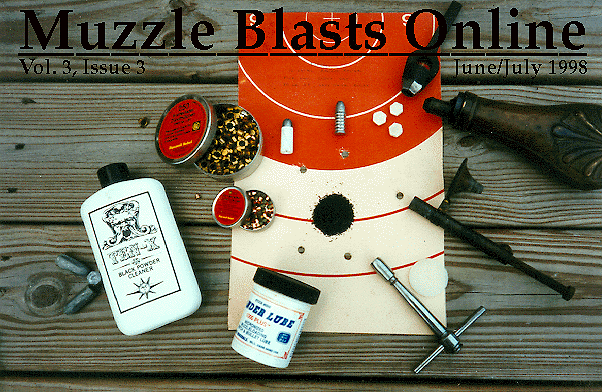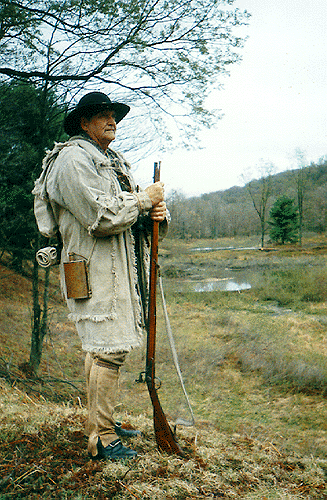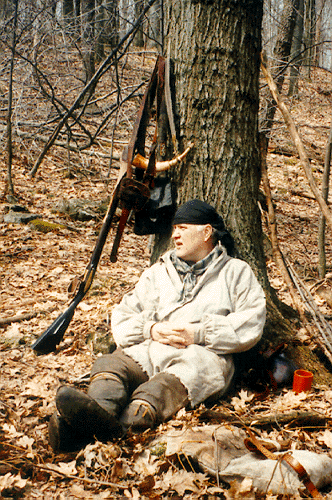|
Muzzle Blasts Online |
|
...for the muzzleloading enthusiast |
|
The muzzleblasts.com domain, subdomains, content, etc., are neither affiliated with the NMLRA nor its paper magazine Muzzle Blasts |
|
Muzzle Blasts Online |

|
|
|
|
|
|
In Pursuit of Experimental Archeology
The path along Irwin Run was soft and quiet from the recent snowmelt. Here in the hemlocks, patches of snow remained, fueling the thin fog that clung to the floor of the little valley. The noise of the stream helped cover my occasional mis-step. My moccasined feet were aware of the forest, floor but every now and then a small stick snapped. The shoepacks I had constructed last year were working well and my feet were plenty warm.

|
|
As Jim Cardamon entered a valley that he had never seen before he said, "This is how it must have looked when the first guys were here." |
Shot pouch and powder horn hung high under my right arm and the waxed linen haversack under my left. Wool half-mittens warmed my hands as they held the .54 caliber Lancaster-style rifle across my chest. The black linen bandanna was tied pirate-fashion around my head and was the one piece of clothing that signaled my presence. That probably needs to be changed, I thought to myself.
The trail along Irwin Run was well worn and I thought of the many times I had hunted here. Today was different, however, and I knew the reason. We were taking advantage of the Pennsylvania black powder season and using it to provide a context for our ever-expanding hobby. Farther up the valley and similarly dressed were my two companions. We were hunting toward each other, expecting to push the deer between us.
Ironically, the shooting had somehow become less important. I moved carefully along the trail and calculated the reasons for that change in thinking. The first firearm I ever owned was a Thompson Center .50 caliber Hawken-just like Jeremiah Johnson, I thought. My friend Jim had extolled the virtues of black powder hunting and to a non-hunter and potential anti-gun advocate his arguments were attractive. The notion of a single shot, fired from a replica antique firearm suggested a challenge and sense of fairness that appealed to me. Perhaps the days of Disney's Davy Crockett were calling out through decades past, but I was soon overcome and off to the woods.
It was not long before the buckskinning hobby found us and we attended our first National Muzzle Loading Rifle Association Eastern Primitive Rendezvous. We were hooked and began to collect mountain man "stuff" like there was no tomorrow. Fifteen years later we have moved through and with the hobby toward a more precise expression of gear and historical understanding. This effort to replicate more precisely the life and times of the American frontier is often referred to as "Experimental Archeology."
By official definition Experimental Archeology is the exacting recreation of clothing, gear, and equipment from the past and then using those recreations in a strict historical environment to experience what it was like to live in the past. In application there is today a diverse array of practitioners. They range from Civil War re-enactors to a growing number of historic "trekkers" who apply their knowledge and skills while traveling through a wilderness setting. The common bond is the use of black powder firearms.
Interest in experimental archeology has exploded in the past decade. Besides the grandfather institution-the NMLRA-the American Mountain Men, the American Long Rifle Association, and the Coalition of Historic Trekkers have moved onto the field and grown to meet the demand for precision in understanding. The principal prophet of the hobby is without question Maker Baker of Franklin, Tennessee. His regular column in Muzzleloader magazine, "A Pilgrim's Journey", has focused on the era of the longhunter and led the way toward accurate portrayal in all aspects of the hobby.

|
|
The author takes a rest on a recent excursion. After attending his first NMLRA Eastern Primitive Rendezvous he was hooked and began to collect mountain man "stuff" like there was no tomorrow |
My trial and frequent error technique has etched some basic truths into my head. These simple rules provide a sensible framework that orient the individual to the hobby. They follow.
1. GET FOCUSED. Direct your interest to a particular time slot and geographic area. Build a persona and accumulate gear that is relevant to these two factors. Achieving this goal is probably impossible without some experimentation and trial and error. Mistakes will happen. Each mistake will sharpen your focus and define more precisely who you are.
2. KEEP IT SIMPLE. Strive to be common or generic to that time and place. This is a thought that is regularly expressed by Mark Baker in his articles and video tapes. An important corollary suggested by Curt Schmidt, a frequent writer on Experimental Archeology, is to collect gear that is relevant to the life of the ordinary frontiersman. This rule can help prevent acquisitions that make no sense.
3. DISCIPLINE YOUR BUYING HABITS. Acquire gear that replicates museum pieces and that lacks interpretive embellishment. Resist the temptation to purchase the item that screams out at you from the trade blanket. Always be sure of its lineage and be sure that it fits your time and place.
4. DOCUMENT YOUR GEAR. Authenticate the museum-quality piece to a primary source (journal or diary) that describes it and its use. This is the challenge as well as the fun. The detective work necessary to become more familiar with your time and place leads to countless hours of enjoyment and frustration. Stick with it.
5. OLDER IS BETTER. People kept things longer in frontier times and were resistant to fads. Besides, technology advanced in those days too. A small-caliber southern mountain rifle, powered by a percussion ignition system, would be technologically wrong for a French and Indian War persona.
6. BEWARE THE KNOW-IT-ALL. The buckskinning hobby, like all of life's pursuits, it populated with self-proclaimed experts and false prophets. Always verify with your primary sources what you hear and read.
7. GET A LIBRARY CARD. A few hours spent researching your time and place will prevent needless cost and wasted effort.
It was spring gobbler season in our woods as I wrote this and last weekend we set out in pursuit of that wily antagonist. Again the hunting was a secondary concern and we concentrated our efforts on expressing our borderman's persona. I tried out my matchcoat for the first time and appreciated its ability to shed the light rain and break the wind that blew early in the morning.
We entered a valley that my friend Jim had never seen before. Jim was more enthusiastic than usual and repeatedly remarked on its beauty. Ultimately he said, "This is how it must have looked when the first guys were here."
With that statement the expense and effort of recreating an accurate portrayal of the frontier borderman paid dividends. Jim had achieved the goal of all Experimental Archaeologists. For a fleeting moment he had traveled in time. It was the 1770's in Western Pennsylvania and he was exploring country that no European had ever seen. He was there.